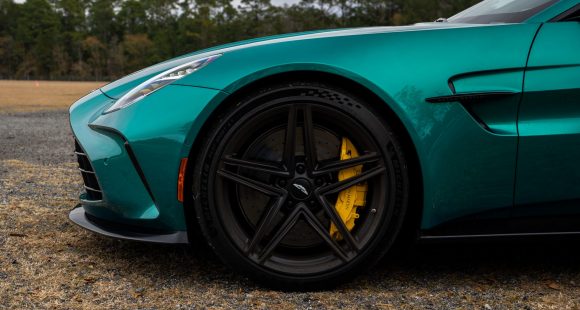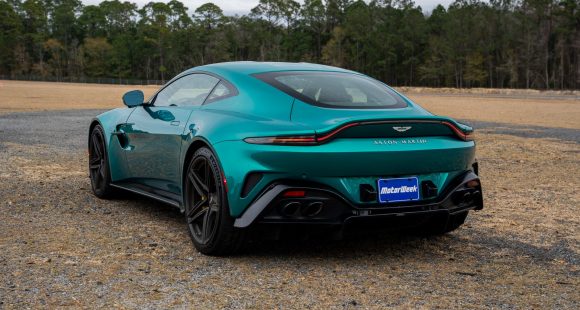2012 Chevrolet Camaro ZL1
Since the Chevrolet Camaro’s rebirth in 2010, sales have taken off right to the top of the pony car field, even outselling its main rival, the Ford Mustang. Yes, it does feel like 1969 all over again, as the pony car wars are continuing to heat up. Indeed the latest shot comes from the general is a 580-horsepower missile going by a familiar name… ZL1.
The 1969 Chevrolet Camaro ZL1 was a born to race, special edition, one year only Camaro, limited to just 69 units. The 2012 Chevrolet Camaro ZL1 has a few similarities to the ’69, but a lot more differences.
For starters, there’s no big-block under the hood, instead it’s GM’s LSA 6.2-liter V8. That’s the same supercharged pushrod pumper found in the Cadillac CTS-V. Improved air flow for both intake and exhaust, as well as updates to the supercharger and intercooler, boost horsepower to 580 and torque to 556 pound feet.
 Another big difference from the original ZL1 that was designed strictly for drag racing, this new ZL1 feels at home on any type of track. As with just about every GM performance car to come along in the last decade, it was designed on Germany’s Nurburgring. While we didn’t sample it there, we did our laps at the closest thing we have in this country, VIR. Virginia International Raceway is a track with lots of high speeds, off camber turns, and elevation changes. It’s not for the faint of heart. And neither is the ZL1. Starting with a Camaro SS, the ZL1 adds stiffer suspension bushings all around, a redesigned rear stabilizer bar, and most importantly, a new version of GM’s Magnetic Ride control.
Another big difference from the original ZL1 that was designed strictly for drag racing, this new ZL1 feels at home on any type of track. As with just about every GM performance car to come along in the last decade, it was designed on Germany’s Nurburgring. While we didn’t sample it there, we did our laps at the closest thing we have in this country, VIR. Virginia International Raceway is a track with lots of high speeds, off camber turns, and elevation changes. It’s not for the faint of heart. And neither is the ZL1. Starting with a Camaro SS, the ZL1 adds stiffer suspension bushings all around, a redesigned rear stabilizer bar, and most importantly, a new version of GM’s Magnetic Ride control.
And the result is… while it still feels a little on the heavy side, this car handles way better than you’re expecting. A new electric power steering unit feels neutral and is very responsive; the Performance Traction Management has five settings to suit track conditions or your driving experience. The Brembo brakes are by far the best we’ve ever experienced on a Camaro; it was hard to get our heads around using them as hard as we were. We didn’t get nearly enough laps to truly find their limits.
On the street, the ride is far from harsh, seating is comfortable, and the ZL1 is fairly well-mannered. 30% of the ZL1’s parts are unique, but most of them you can’t see, like aerodynamic enhancements under the body, a new rear differential that shares the transmission coolant, and additional pick-ups in the fuel tank.
Exterior enhancements are much easier noticed, and include a big front splitter, a new grille that feeds large brake cooling ducts and a carbon fiber hood with vents that not only get air out of the engine bay but provide additional front end down force as well. There are also extended rockers and fenders, and of course a rear spoiler. 20-inch wheels are standard and wrapped in Good Year Eagle F1’s, 285/35’s up front, 305/35’s in the rear.
 Inside, the ZL1 gets a mild make-over with suede leather replacing the plastic trim on the dash and doors. The improved seats also get the suede treatment, and an optional Suede Package spreads hide onto the steering wheel and shifter as well. It’s also loaded. Bluetooth, back-up cam, and even Head-up Display, are all standard. You have your choice of 6-speed transmissions, manual or automatic; and just as in the CTS-V, the automatic is actually quicker to 60 by a tenth at 3.9-seconds. Top speed…180!
Inside, the ZL1 gets a mild make-over with suede leather replacing the plastic trim on the dash and doors. The improved seats also get the suede treatment, and an optional Suede Package spreads hide onto the steering wheel and shifter as well. It’s also loaded. Bluetooth, back-up cam, and even Head-up Display, are all standard. You have your choice of 6-speed transmissions, manual or automatic; and just as in the CTS-V, the automatic is actually quicker to 60 by a tenth at 3.9-seconds. Top speed…180!
But, the manual achieves better Government Fuel Economy Ratings at 14-City and 19-Highway, while the automatic manages just 12 and 18. Those low numbers do warrant a Gas Guzzler Tax; still, much like the Chevrolet Corvette, the Camaro ZL1 delivers world class performance, without an exotic price tag, starting at just $54,995, with very few options available.
The 2012 Chevrolet Camaro ZL1 is a truly contemporary muscle car. More than just a flimsy pony car made for the drag strip, it’s a high performance missile that can streak around any corner. And, it has clearly shot the Camaro to the top of the pony car field for now. With a 650-horsepower Shelby GT 500 Mustang on the way, will the ZL1 stay there for long? Well we can’t wait to find out. Welcome back to the 60’s - peace, love, and muscle cars, baby!
Specifications
- Engine: 6.2-liter V8
- Horsepower: 580
- Torque: 556 lb-ft.
- 0-60 mph: 3.9 seconds
- EPA: 14 mpg city/ 19 mpg highway (manual)
2025 Aston Martin Vantage
Gorgeous Aston Martin Gets Nasty With Performance
Aston Martin has a long history of delivering high-performance vehicles packed with classic British elegance. But with their latest Vantage coupe, Aston Martin has seriously cranked up the performance part of that formula. So, let’s hit the track and see how it all comes together.
We’re ripping through the nine high-speed turns of Savannah’s Roebling Road Raceway as fast as possible, trying to outrun an epic winter storm that’s about to shut down most of the South. And this 2025 Aston Martin Vantage seems to be enjoying it as much as we are. Quite simply, we didn’t expect the Vantage to be this inspired. After all, Aston has used the Vantage name on a variety of vehicles over the years, but this particular coupe arrived for 2019 and gets a proper and prodigious refreshing for 2025.
Visually, it’s an absolutely gorgeous piece of machinery, with the exaggerated proportions that would be borderline cartoonish if they weren’t so exquisitely executed. And despite decades of improving camera technology, our lenses simply can’t truly portray the depth and beauty of this Podium Green paint job, part of the “Racing Line” collection.
Now, it may look all British sports car outside, but it still gets its power from a German V8; AMG’s hand-assembled 4.0-liter twin-turbo unit, and for those keeping score at home its 656-horsepower output is a healthy 128 horsepower increase over last year. It sends its 590 lb-ft of torque to the rear wheels through an eight-speed automatic transmission. Somehow this European union comes out feeling more NASCAR than sports car, as the Vantage is crazy fast and a handful to drive.
For being a GT car at heart, the Vantage has a very dynamic feel to it with way more feedback than the typical Grand Tourer. And considering the last Aston Martin we drove was an SUV, it’s great to be back in a proper British sport coupe that’s willing to get down to business on a racetrack. Even with that monster motor up front, the Vantage’s bonded aluminum structure enables perfect 50:50 weight distribution, and you feel right in the middle of it.
The Vantage has a very dynamic feel to it with way more feedback than the typical Grand Tourer.
A complete suspension overhaul includes Active Vehicle Dynamics with adaptive dampers, an electronic rear differential, and new 21-inch Michelin PS 5s. It all works through Adjustable Traction Control with eight levels of intervention, including full-off if conditions are appropriate. It does have some roll to it, but it feels very natural. Integrated Brake Slip Control modulates braking on turn-ins, and with the Carbon Disc upgrade, braking performance was exceptional once they were warmed up. ABS was quick to trigger until we got some heat into them, after which point their bite was strong and consistent.
The biggest takeaways from our track time: it feels insanely powerful and sounds incredibly ferocious, yet at the same time, it’s so smooth and refined it’s easy forget your speed. Alas, we couldn’t outrun that snowstorm which arrived before we could do any acceleration runs, but we expect the Vantage can do a mass Brexitous to 60 in 3.4 seconds, aided by a new Launch Control system.
It feels every bit as special inside. The cockpit is a little tight, but everything is within easy reach and logically placed. The Mercedes-Benz influence is much less noticeable with an all-new console and center stack. Switchgear and materials feel exquisite and purposeful, with lots of carbon fiber and leather. The 10.3-inch infotainment screen is another big change, as the Vantage gets Aston’s new in-house system first seen in the DB12.
Government Fuel Economy Ratings are 15 City, 22 Highway and 18 Combined.
Vantage pricing starts at $194,500, with plenty of ways to make that number climb in a hurry.
Staying true to the brand while absolutely tearing up a racetrack, well, you really can’t ask for anything more than that. That’s what makes the 2025 Aston Martin Vantage so special. It’s a great place to spend your high-performance dollars if you’re looking for something a little different, but with even more of the familiar thrills.
Specifications
As Tested
- Engine: 4.0-liter twin-turbo V8
- Transmission: 8-speed automatic
- 0-60 mph: 3.4 seconds
- Horsepower: 656
- Torque: 590 lb-ft























































